|

 Up
Up 
 The Tale of
The Tale of
The Vin Fiz

(You are here.)
 Down
Down




  Need
to Need
to
find your
bearings?
Try
these
navigation aids:
If
this is your first
visit, please stop by:
Something
to share?
Please:



|
|
Available in Française, Español, Português, Deutsch, Россию,
中文,
日本, and others.
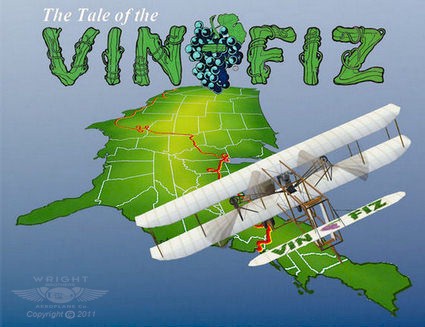
I
endure. I conquer.
— Inscription
on the gravestone of Cal Rodgers.
 mongst
the gifts that the invention of flight has given us, perhaps the most
inspiring are its heroes. The very first flight on 17 December 1903 was a
tale of courage and tenacity, and that has set the tone for much of the
history of aviation. The National Aviation Hall of Fame in Dayton, Ohio
has enshrined dozens of these heroes since its inception, and among the
first was Calbraith Perry Rodgers, the first pilot to fly across the
United States. mongst
the gifts that the invention of flight has given us, perhaps the most
inspiring are its heroes. The very first flight on 17 December 1903 was a
tale of courage and tenacity, and that has set the tone for much of the
history of aviation. The National Aviation Hall of Fame in Dayton, Ohio
has enshrined dozens of these heroes since its inception, and among the
first was Calbraith Perry Rodgers, the first pilot to fly across the
United States.
Cal Rodgers was born in 1879 to a prestigious
family of naval
heroes. A
childhood disease resulted in a profound hearing loss. This prevented him from joining the Navy, so he took to the
air. Despite his deafness, he was among the first aviators to learn to fly at the Wright Flying
School at old Huffman Prairie near Dayton, Ohio. Almost as soon as he had
learned to fly, he set out to capture the coveted
Hearst
Prize. Publisher
William Randolph Hearst had offered a $50,000 purse to the first aviator
to fly coast to coast in 30 days or less. Rodgers enlisted the Armour
Meat-Packing Company as a sponsor, promising to promote their new soft
drink, "Vin Fiz." He purchased a
Wright Model EX biplane, christened it the Vin
Fiz, and on 17 September 1911, he took off from Sheepshead Bay on
Long Island, New York.
Cal Rodgers did not win the Hearst Prize. Almost from the first
take-off, he was
beset by problems, many of which should have ended his
journey. Less than a day out from Sheepshead, he wrecked his aircraft and
had to completely rebuild it — a delay that cost him several days. And
this was only the first of five major crashes, two engine explosions, and
dozens of minor incidents. In addition to his mechanical problems, he was
plagued with navigational errors. The Vin Fiz carried no
directional instruments, not even a compass. Cal Rodgers was forced to
"follow the line," navigating from town to town by following
railroad tracks. Occasionally he picked the wrong track and traced it for
miles before he landed and found he wasn't where he expected to be.
Finally, he was handicapped by his hearing loss. According to Henry Kisor,
a deaf pilot who has himself flown the route of the Vin Fiz, "On
quite a few occasions Rodgers made judgmental errors very likely because
he could not hear."
Nonetheless, he kept flying. Even when he had spent over 30 days
crossing the continent, the hope of winning the Hearst Prize had
evaporated, and everyone connected with the endeavor expected him to quit,
he kept flying. His
refusal to give in endeared him to the American
public, and the crowds that met each landing grew larger and more
enthusiastic after the prize was lost. When he finally landed at Long
Beach, California, on 10 December 1911 — 84 days after he had left Sheepshead — 50,000 cheered him as he wet the wheels of the Vin Fiz in
the Pacific surf. Several months later, when he died in a flying accident
near the spot where he had complete his transcontinental flight, a whole
nation mourned the loss of one of aviation's first heroes.
Cal Rodgers was enshrined in the National Aviation Hall of Fame on
17 December 1964, along with Orville and Wilbur Wright and several other
aviation pioneers. The inscription on his posthumous award reads, "To Calbraith Perry Rodgers, for
outstanding contributions to aviation by
demonstrating the feasibility of transcontinental flight, this award is
most solemnly and respectfully dedicated."
|
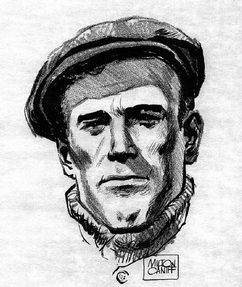
Milton Caniff's portrait of Cal
Rodgers hangs in the National Aviation Hall of Fame.
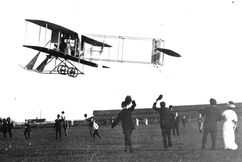
The Vin Fiz takes off from Sheepshead Bay, Long
Island, New York on 17 September 1911.
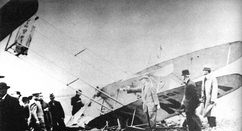
The Vin Fiz wrecked in Huntington, Indiana, one of
several major crashes along the route. Although Cal was not hurt in most
crashes, they cost precious time.
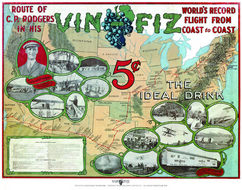
This Vin Fiz promotional poster from 1911 depicts
Cal's route across the United States. However, it does not show all the
detours he took when he got lost. (This poster is available at
drinkvinfiz.com.)
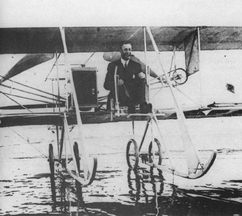
Cal Rodgers wets the wheels of the
Vin Fiz in the surf
at Long Beach, California, after flying 4,231 miles (6809 kilometers) in 84 days.
|
|
Other Voices
-
Been
There Done That The tale of the Vin Fiz is
memorable for Cal Rodger's remarkable endurance, refusing to quit his
transcontinental flight in the face of wrecks, injuries, financial
hardship, flying on even when the prize was lost. But then, Rodgers was
made of strong stuff. He was almost stone deaf in an era that did not
understand, accommodate, or even make allowances for the physically
challenged, yet he never let his deafness define what he could or
could not do. This has made his accomplishments all the more inspiring,
particularly to the deaf community. And it is why pilot Henry Kisor, a syndicated
columnist, journalism professor at Northwestern University, editor at
the Chicago Sun-Times, and deaf since he was three, decided to
retrace the adventure of the Vin Fiz in his own small airplane.
|
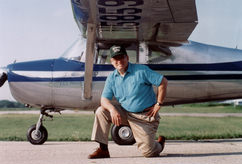
Pilot/journalist/professor Henry Kisor in front of his Cessna 150,
the "Gin Fizz."
|

